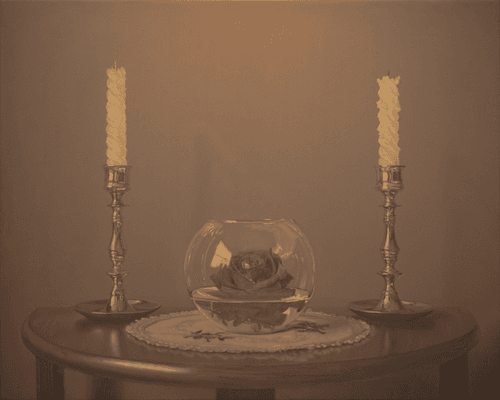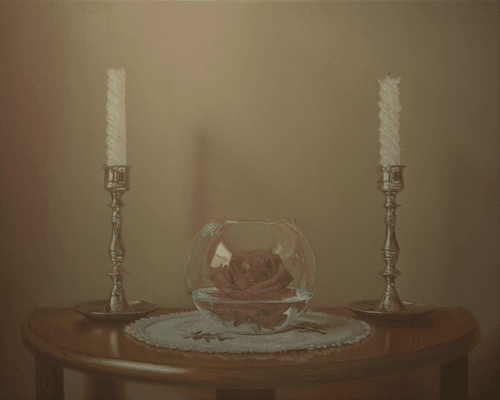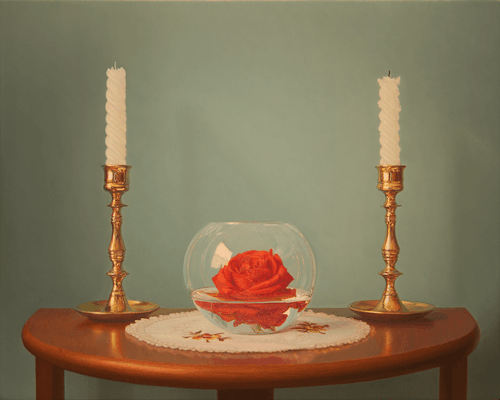Example painting - Candles and Rose
The following outlines a four-stage process, each illustrated with a brief description and an accompanying image.
Approach
I begin with a symbolic concept and then gather and arrange supporting objects. When applying paint, my initial aim is to faithfully represent how light defines the forms. As the painting progresses, I strive to explore a tactile and atmospheric reality, shaped by my choices of colours and tonal values while maintaining the established relationships within the composition. Upon completion, I hope to offer a glimpse of a renewed realism, perhaps subtly conveying the tangible presence of objects like candles and a rose.
Materials
My approach to painting materials can be summed up by the simple and humorous axiom "Just paint," which reflects how many of my peers perceive my simplified approach. I employ a professional brand of highly pigmented permanent oil paints manufactured by Old Holland. As a rule, I refrain from adding any solvents or mediums to my paints. My preferred brush type is Kolinsky Sable, although I utilize various types of brushes as needed. For my painting support, I favour braced wood panels crafted from high-quality hardboard or birch plywood. Finally, I protect my finished works with a final satin varnish, GamVar by Gamblin, to which I add a small amount of cold wax medium.

1. Candles and Rose - Grounds
My paint application process begins with meticulous preparation of the support and ground. I have exacting standards for this stage. Typically starting with a wood panel, I seal it with several layers of GAG100, an acrylic polymer emulsion. This is followed by the application of multiple thin layers of white oil or acrylic ground. These primer layers are carefully applied and smoothed to achieve a uniform finish. Subsequently, lead white paint is applied. The final lead layers are subtly tinted with colours that harmonize with the subject matter. Careful consideration is given to tonal values, ensuring they generally do not exceed the intended middle values of the finished painting.

2. Candles and Rose - Sketch In
This stage, often referred to as the "drawing" stage, involves meticulous attention to accurately rendering lines and tonal shapes. This step establishes the foundational forms and overall value range within the painting. I prefer to begin this stage with darker earth colours such as Brown Ochre Deep and Red Ochre. Some Ivory Black and Lead White may also be introduced at this point.

3. Candles and Rose - Dead Colour
The term "dead colour" stage should not be misconstrued as implying a somber or lifeless approach. Historically, it refers to the use of a very limited palette, typically consisting of earthy tones. Building upon the preliminary sketch, I will introduce a few earth tube colours. While restricted to approximately five colours, this palette allows for the mixing of a multitude of hues and values, albeit with a limited saturation range, to further develop the rendering. For instance, a blue can be achieved by mixing predominantly black and white, creating a cooler tone. However, in certain instances, I may opt to underpaint the final blue area with a complementary warm hue.

4. Candles and Rose - Final
This example does not illustrate all intermediate stages. After completing the dead painting layers, a few more oil paint tube colours were added to expand the palette range. These typically included yellow, red, and blue. This artwork also required the addition of Viridian Green. Towards the end of a painting, colour mixtures tend to be blended to achieve purer hues. Variations in saturation can be achieved by adjusting the thickness of the paint application. The final stages were determined by how the painting developed a structured configuration of tones and values.
My primary goal is to create a unified composition and establish a strong connection between the overall effect and my initial concept.